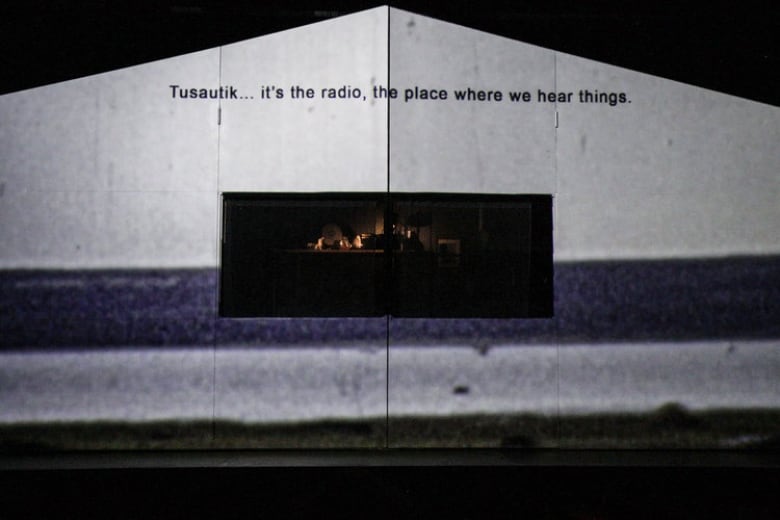Multisensory play brings the sounds, smells and stories of Nunavik to the South
Aalaapi highlights lives of women, pivotal role of radio in the North

Olivia Ikey Duncan and Niap say their multisensory play is nothing like people in the South have experienced before.
It's set in Nunavik and the main character is the radio.
Through their onstage performances, Niap (who goes by one name only) and Ikey Duncan share the culture of the North in a play titled Aalaapi — an Inuktitut word that means be silent, so you can hear something beautiful.
The Inuktitut play has English and French subtitles and was performed in Sherbrooke and at the National Arts Centre in Ottawa last month.
Come Nov. 11, it will be in Montreal at the Théatre Rouge du Conservatoire D'Art Dramatique to perform in front of an international audience at the CINARS festival, one of the premier performing arts conferences in the world. Tickets are no longer available for that staging.
Highlighting the role of radio and community

Aalaapi first started out as a podcast of young Inuit women talking about their daily lives, hopes and dreams.
Produced by Marie-Laurence Rancourt, it was then turned into a live performance, directed by Laurence Dauphinais, to showcase the women's experiences and the central role of radio.
The play is unconventional, says Niap, as it engages the audience's sense of smell, as well as the usual sight and sound.
"I make my very famous bannock," said Niap, a multidisciplinary artist.
"There's a certain point in the play where it's completely dark and you don't see anything … Theatre is always in action and you see everything that's going on and you [are] always watching. Whereas this play is very, very contemplative. We bring the tempo very slow," said Niap.
WATCH | You can watch the trailer of Aalaapi here:
Through the radio, the stories and messages of the North are shared throughout the performance. It illustrates its central role in communities, said Ikey Duncan.
"It's a level up from Facebook still," said Ikey Duncan. "It's on all the time… If I need [Niap] to call me or go pick up my daughter at daycare, I'm going to call the radio and say, '[Niap], you gotta go pick up my daughter.' And they'll announce it and she will most likely be listening," said Ikey Duncan with a laugh.
Niap says there is a playfulness with the radio back home that encourages community. At Christmas time people call in to wish each other a happy holiday and play games on air — something particularly important for those who don't have access to Wi-Fi.
"My mother doesn't have Wi-Fi … So that's tough. The radio is the main line of communication," said Niap.
Ikey Duncan says this project brings that sense of the community in Nunavik to people living in the South.
"Aalaapi is bringing the pace of home, the sounds of home back to the South … it's to have the audience relax for an hour and a half and be brought to the Arctic," said Ikey Duncan.

Aalaapi feels like 'home'

Ikey Duncan first got involved in the play in October 2022 after watching a performance in 2019 when she was a student.
"It felt like home," said Ikey Duncan. She says she had worked with Niap on spoken word pieces before joining the cast.
"I'm new to this … I'm not an actress at all. But it's home, that's the thing. And we're not acting like Romeo and Juliet or we're not acting something that is made up. We're performing as if it's real life."
She says the play, although scripted, is conversational and casual — a performance ultimately focused on "two women, listening to the radio in their cabin, making bannock."
The stage is set up to look like the facade of a house. Images of maps, ancestors and cultural activities are projected onto the house, playing in the space around the windows.
"The only action that you see on stage is behind the window. So you're kind of like a voyeur looking through this window of this woman's house," said Niap.
LISTEN | Niap and Olivia Ikey Duncan talk about Aalaapi on Quebec AM:
Changing the narrative on Nunavik
Niap says this play encourages audiences to view Nunavik through a different lens by identifying issues in the North and their efforts to ensure "a good future."
Niap says this message begins even before the actors walk on stage as the audience shuffles to their seats, talking loudly among themselves.
"They're probably talking about what they're going to do this evening, tomorrow or this week or, talking to their friends just waiting for the show to start and you hear on the radio, it's playing already," says Niap.
In Inuktitut, an announcement rings over the crowd: "We need everybody to know that the water, is not something that you should be drinking right now … Boil it for at least one minute. And if you are pregnant, please refrain from drinking the water and giving it to your young babies."
The kicker, said Niap, is that no one is listening. She says it illustrates how people from the South are often "not aware of the struggles."

"It kind of goes to show that disconnect that exists between the South and the North, and that's what we're trying to do … bring awareness to who we are as a people today in a modern society," said Niap.
"I think what people should realize is that we are a struggling people, but we do have hopes and we do try our best to have a good future."

